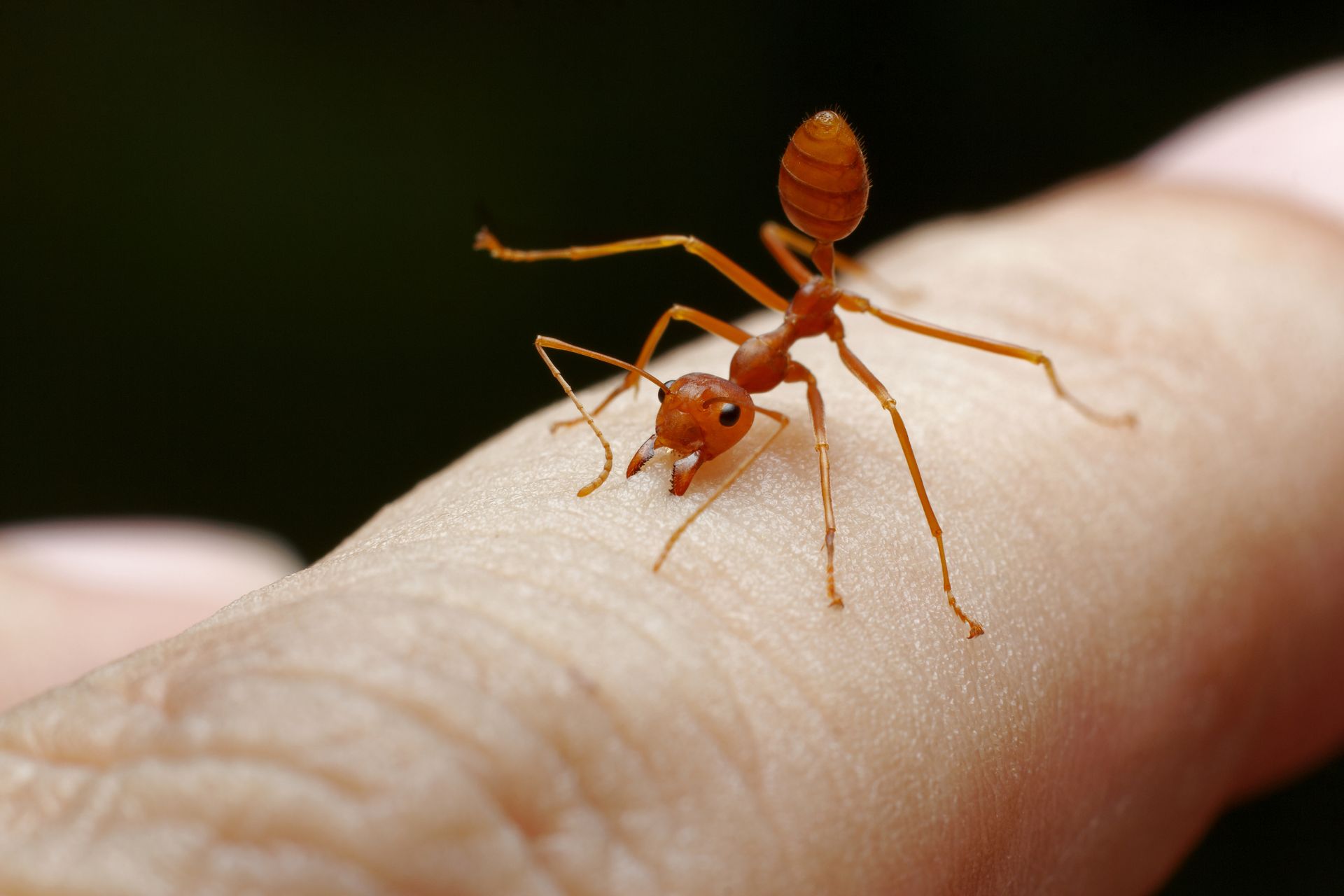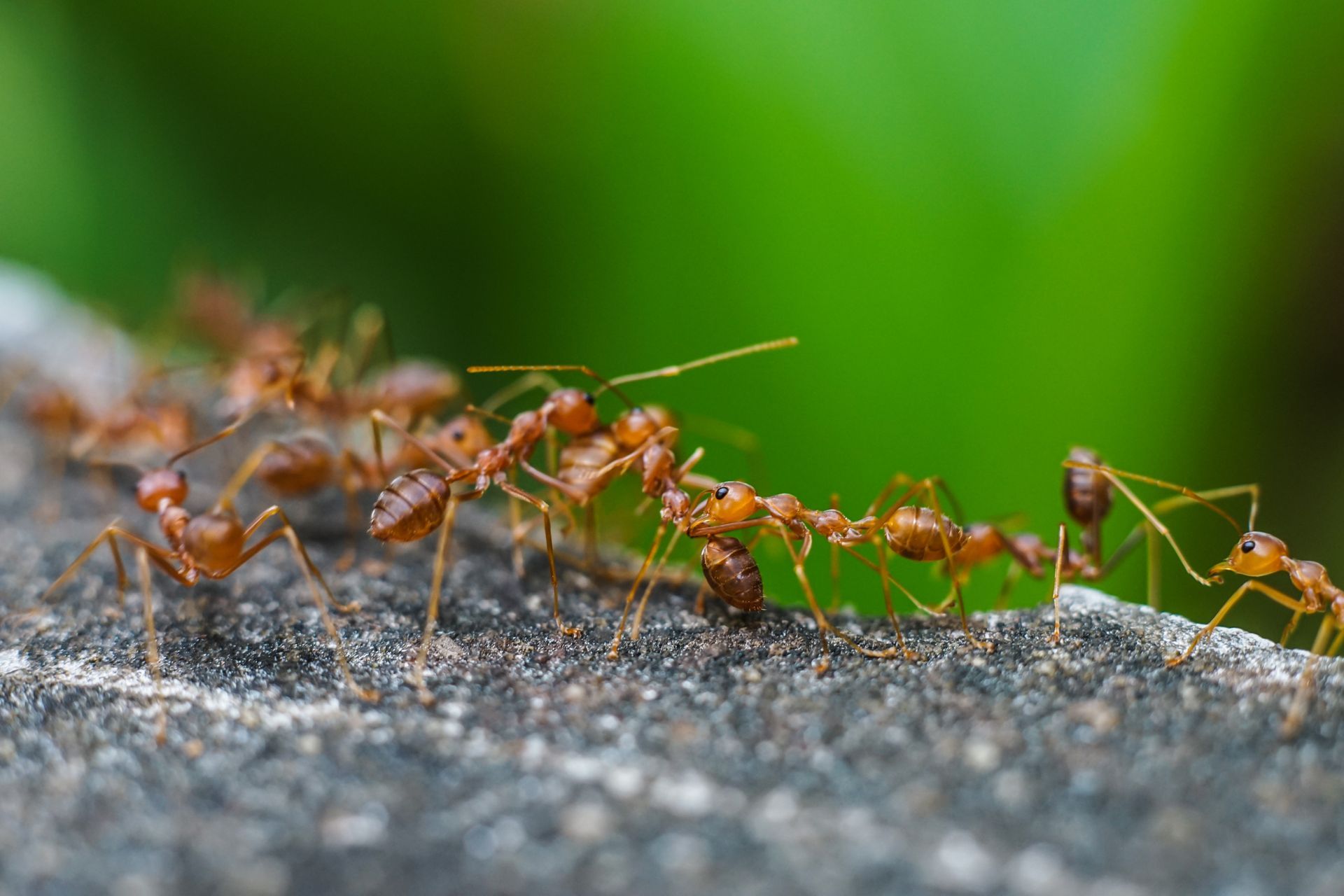What Are Red Ants?

Red ants, specifically known as Red Imported Fire Ants (RIFAs), derive their name from their notorious ability to deliver painful bites and stings. These dark reddish-brown ants are an invasive species predominantly found in the southern regions of the United States. Renowned for their aggressive nature, red ants can pose significant challenges to homeowners and outdoor enthusiasts alike. Their presence is not only a nuisance but also a potential health hazard due to their venomous stings which can cause severe reactions in some individuals. Understanding what red ants are including their behavior, habitat, and impact is crucial for effective management and control of these persistent pests.
Are Red Ants and Fire Ants the Same?
Not all red ants are fire ants, and not all fire ants are red. While "fire ant" often evokes images of bright red insects, these ants actually exhibit a range of colors from reddish-brown to deep mahogany. True fire ants belong to the genus Solenopsis and are known for their aggressive behavior and painful stings. Among these, Red Imported Fire Ants (RIFAs) are the most prevalent in the United States. They were accidentally introduced from South America in the 1930s through soil used in ships' ballast tanks and have since become a significant pest across 15 southeastern states.
Several ant species fall under the umbrella term "red ants":
- Red Imported Fire Ants (RIFAs): These most common red ants are aggressive and have a painful sting.
- Tropical Fire Ants: Almost identical to RIFAs, but with larger, square-shaped heads. They are found in dry, coastal areas of Hawaii and the southern United States.
- Southern Fire Ants: Also known as desert or California fire ants and these ants prefer arid climates. They are commonly found in Texas, New Mexico, Arizona, and California and have smaller, looser mounds than other fire ants.
Despite their different habitats and slight variations in appearance, all these fire ant species pose significant challenges due to their painful stings and invasive nature. Understanding the distinctions between these ants is crucial for effective identification and management.
Fire Ant Classification
The genus Solenopsis encompasses over 200 species of stinging ants known for their aggressive behavior, painful stings, and their reddish coloration. The term "red ant" is sometimes used interchangeably for different ant species that share similar reddish hues but do not possess the same characteristics as true fire ants. Understanding the classification of fire ants helps in accurately identifying and managing these pests.
Identifying Fire Ants
Identifying fire ants involves observing several key physical characteristics. Red Imported Fire Ants (RIFAs) are the most common fire ant species in the United States and can be recognized by key features like their characteristics and size.

Fire Ant Characteristics
Fire ants are easily identified by their distinctive reddish-black coloration and body structure consisting of head, thorax, and abdomen. The queen and worker fire ants typically have a reddish brown head and thorax with a black rear segment. Male swarmers are entirely black which make them distinct from the workers and queens. Like all insects, fire ants have a hard exoskeleton that provides protection and support, six legs, and a pair of antennae. Worker fire ants are characterized by their rounded heads equipped with powerful mandibles, a fortified thorax, and an abdomen divided into the pedicle and gaster segments. Additionally, fire ants in the genus Solenopsis can be identified by their pedicel with two nodes, an unarmed propodeum, and antennae with 10 segments plus a two-segmented club. These characteristics help differentiate fire ants from other ant species.
How Big Are Fire Ants?
Worker fire ants exhibit a range of sizes, varying from small individuals measuring about 1/16 inch to larger ones reaching nearly 1/4 inch in length. This polymorphism, where worker ants differ significantly in size within the same colony, is a distinguishing characteristic of fire ants. In contrast, many native ant species tend to have worker ants that are uniform in size. This size variation among fire ant workers allows them to perform a variety of tasks within the colony which contributes to their adaptability and ability to thrive in environments they are introduced into.
Fire Ant Behavior
Fire ant colonies are known for constructing large, irregularly shaped mound nests that can span areas of two to four square feet. These mounds are commonly found in open areas and can be introduced into new locations through potted plants, shrubs, and trees. Fire ants primarily feed on young plants, insects, and seeds but they are also known to attack and kill small animals that they can overwhelm.
Fire Ant Habitat
Fire ants typically nest in soil in moist areas like riverbanks, pond shores, and watered lawns. Their nests typically remain hidden under objects like timber, logs, rocks, or bricks. In the absence of cover, fire ants will build visible, dome-shaped mounds in open spaces like fields, parks, meadows, and lawns. These mounds can vary significantly in size and range in height from 16 inches to 3.5 feet and span up to 5 feet in diameter.
What Attracts Red Fire Ants?
Red fire ants are attracted to several factors that make an environment ideal for their survival and colonization. Here are the key attractants:
- Food: Red fire ants are omnivorous and attracted to a wide variety of food sources. They are particularly attracted to sugary substances, proteins, and fats. Ensuring that food spills and crumbs are cleaned up immediately and performing routine deep cleaning can help prevent attracting these ants.
- Moisture: Like all ants, red fire ants require water to survive. These ants thrive in humid conditions and are frequently found near water sources like leaking pipes and damp areas. Ensuring that your property is free from leaks and moisture build-up can reduce the likelihood of an infestation.
- Shelter: Red fire ants seek shelter in dark and damp environments to build their nests. They may build colonies in walls, floorboards, or abandoned tunnels made by other insects. To prevent this, inspect your property for cracks in walls or foundations and seal them to deny ants access.
By addressing these attractants, you can make your property less appealing to red fire ants and reduce the chances of an infestation.
Fire Ant Colony Hierarchy
Fire ant colonies have a complex and well-defined hierarchy that consists of different castes that each play specific roles. This social structure allows the colony to function efficiently and grow rapidly. Here’s a breakdown of the red ant castes:
- Queen: The primary reproductive female is generally the largest ant in the colony. A single queen can produce up to 1,600 eggs daily after mating. Unlike other single queen any species, red ants can develop multiple queens that will create satellite colonies that branch off the parent colony.
- Males (drones): Male fire ants' sole purpose is to mate with queens during their nuptial flights. After mating, males are not accepted back into the colony and will eventually die outside the nest. They do not participate in the colony's day-to-day activities.
- Workers: Workers perform the essential tasks within the colony and are divided into different size classes: minima, minor, media, and major. Major workers are larger and have powerful mandibles for macerating and storing food. Smaller workers take care of the queen’s eggs, larvae, and pupae, clean the nest, and forage for food. Each size class of worker ants contributes to the colony's overall efficiency and survival.
This hierarchical structure enables fire ant colonies to thrive and expand rapidly which make them formidable pests in many environments.
Why Are Fire Ants a Problem?
Fire ants have a significant and wide reaching impact on local environments and ecosystems. They aggressively feed on a variety of ground-nesting and feeding fauna including insects, spiders, lizards, frogs, birds, and mammals. This predatory behavior can displace or even eliminate native species which can lead to major disruptions in local biodiversity. Fire ants also damage seeds which can potentially cause long-term changes in the plant communities they inhabit. Their ability to outcompete native species and their aggressive nature make fire ants an invasive pest that poses serious ecological challenges.
They are also disastrous for the economies of the areas they infest. The economic impact fire ants have is profound, with the FDA estimating over $5 billion spent annually on medical treatment, damage repair, and pest control efforts in the US alone. These ants cause approximately $750 million in agricultural damage to crops, livestock, and related industries every year.
Are Fire Ants Invasive?
Fire ants are highly invasive and pose significant threats in many parts of the world including the United States, Australia, China, and Taiwan. Believed to have been accidentally introduced through shipping crates, these ants have established themselves as invasive pests in various regions. In the United States, over 40 million people live in RIFA-infested regions which are typically southern and gulf states. Other fire ant species also exhibit invasive characteristics and have spread across tropical countries which further complicates management efforts in affected areas.
Are Fire Ants Aggressive?
Fire ants are notoriously aggressive, especially when their nest is disturbed. Unlike many other ant species that may take longer to react or may not react aggressively at all, fire ants will swarm immediately to defend their colony. They attack in groups, using their numbers to overwhelm perceived threats. This collective defensive behavior makes them particularly dangerous to humans and animals that accidentally come into contact with their nests.
Their aggressive nature extends beyond nest defense. Fire ants are more aggressive than most native ant species and often push insect and animal species out of their local habitats. This aggressive displacement contributes to their invasive success which allows fire ants to dominate new environments quickly. Their readiness to swarm and sting en masse is a key factor in why fire ants are such a significant problem that poses risks to people, pets, livestock, and wildlife alike.
Do Fire Ants Bite or Sting?
These aggressive, venomous insects employ a two-step attack: first biting to secure their position, then stinging. When disturbed, fire ants will latch onto their target with their mandibles to secure a grip, then inject venom through a stinger located in their abdomen. Their venom, solenopsin, is a potent alkaloid that induces an intense burning sensation, reminiscent of fire. While the stings are painful and uncomfortable for most individuals, they can be particularly dangerous for those allergic to insect venom. In severe cases, fire ant stings can trigger life-threatening reactions that require immediate medical attention.
Where Do Fire Ants Bite?
Fire ant stings most commonly occur on the feet or legs after someone accidentally steps on or near a fire ant mound. When the mound is disturbed, fire ants swarm quickly and target the threat. Since fire ant mounds are often inconspicuous and can be hidden in grass or soil, it's easy to unknowingly step on them which can lead to multiple stings concentrated on the lower extremities.
What Happens When You Get Bit by a Fire Ant?
When you get stung by a fire ant, you experience a painful sting that leaves a burning or itching sensation on the skin, which can last up to an hour. Fire ants tend to swarm, meaning encounters often involve tens or hundreds of ants stinging simultaneously and repeatedly. The venom which is primarily composed of oily alkaloids causes a local burning sensation followed by urticaria. The sting site typically swells into a bump within hours, which can further irritate, especially if multiple stings occur in the same area. Within 24 to 36 hours, these bumps may develop into white pustules, which can become infected if scratched. While pustules are obtrusive and uncomfortable, they generally flatten within a few days if left undisturbed.
What Should You Do if You’ve Been Stung by a Red Fire Ant?
If you've been stung by a red fire ant, it's important to take immediate steps to alleviate pain and prevent infection. Start by washing the affected area with soap and water to remove any remaining venom. Applying a cold compress can help alleviate swelling and discomfort. Over-the-counter topical treatments such as benzocaine, diphenhydramine (an antihistamine), or hydrocortisone cream can be used to relieve itching and inflammation. Oral antihistamines can also help manage itching and swelling. If you experience severe allergic reactions like chest pain, nausea, severe sweating, difficulty breathing, or significant swelling, it is best to seek emergency medical attention immediately as these symptoms can be life-threatening. Home remedies like aloe vera gel can provide additional relief, but always ensure they are used in conjunction with medically verified treatments.
How Long Do Fire Ants Live?
Fire ant lifespans vary significantly between the different castes within the colony. Worker fire ants typically live for about 4-6 weeks while diligently performing tasks like foraging, caring for the queen's eggs, and maintaining the nest. Fire ant queens boast remarkable longevity, with lifespans extending up to 7 years or more.
What Do Fire Ants Do to Survive?
Fire ants employ various strategies to survive in diverse and often extreme conditions. Their waxy exoskeleton not only protects them from dehydration in hot climates but also helps them expel water during floods. This survival strategy was notably demonstrated during Hurricane Harvey in Texas (2017), when floating clusters of fire ants known as rafts were observed on floodwaters. These rafts contained up to 100,000 individual ants and formed temporary structures that allowed the ants to survive until they were able to find a new, permanent home. The ants within the raft can adapt their behavior to different fluid flow conditions to ensure the stability and survival of the entire group.
How to Prevent Red Imported Fire Ants
To prevent red imported fire ants, take the following measures:
- Remove food attractants: Maintain a clean home environment, free of food debris and crumbs. Store food in airtight containers and promptly clean up spills to discourage ants from entering in search of food.
- Block entry routes: Locate and seal any potential ant entry points, including cracks, gaps, or openings in your home's structure, both inside and outside.
- Follow professional recommendations: Consult pest control professionals for specific advice tailored to your situation and follow their guidance for the best results.
- Conduct regular inspections: Schedule routine pest inspections to detect and address ant infestations early before they become severe.
- Avoid disturbing nests: Actively avoid fire ant mounds and nests, as disturbing them can provoke the ants to sting, leading to painful welts.
How to Get Rid of Red Ants
To effectively get rid of red ants, follow these steps:
- Accurate species identification: Correctly distinguish between less harmful red ant varieties and the more dangerous red imported fire ants to ensure appropriate treatment.
- Consult pest professionals: Contact a licensed pest control service for a thorough inspection and a tailored treatment plan. Professionals have the expertise and tools necessary to manage ant infestations effectively.
- Professional treatment preferred: While DIY ant control products are available, they often provide only temporary relief and may not address the root cause of the infestation. Professional treatments are typically more effective and long-lasting.
Contact EcoGuard if You Are Dealing with Red Ants
Dealing with a red ant infestation can be challenging and potentially hazardous. For comprehensive and effective solutions, it's crucial to rely on professional pest control services. EcoGuard Pest Management offers expert inspections, personalized treatment plans, and proven methods to eliminate red ants from your property. Don't let these aggressive pests disrupt your home or harm your loved ones. Contact EcoGuard Pest Management today for reliable, safe, and efficient pest control services to ensure your home remains ant free.
Red Ant FAQs
Why are red ants harmful?
Red ants are harmful because their aggressive nature and painful stings can cause severe allergic reactions in humans and animals and lead to significant health risks. Additionally, they disrupt local ecosystems by displacing native ants, insect, and animal species and can cause considerable damage to crops, livestock, and infrastructure.
What's the difference between red ants and fire ants?
The term "red ants" is a general descriptor for various reddish ant species, while "fire ants" specifically refers to members of the genus Solenopsis that are known for their aggressive nature and painful stings. Not all red ants are fire ants, but all fire ants are typically reddish and pose significant ecological and health threats.
Do red ants sting or bite?
Red ants, particularly fire ants, employ a two-stage attack: first biting to secure their grip, then delivering their painful sting. They latch onto their target with their mandibles to secure a grip and then inject venom through a stinger in their abdomen, causing a painful and burning sensation.
Are red ants in the house good or bad?
Red ants in the house are generally bad because they can contaminate food, cause structural damage, and deliver painful stings. Their presence often indicates larger infestations which can be difficult to control and eliminate without professional pest management.

















